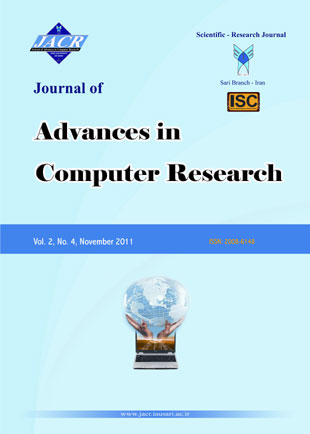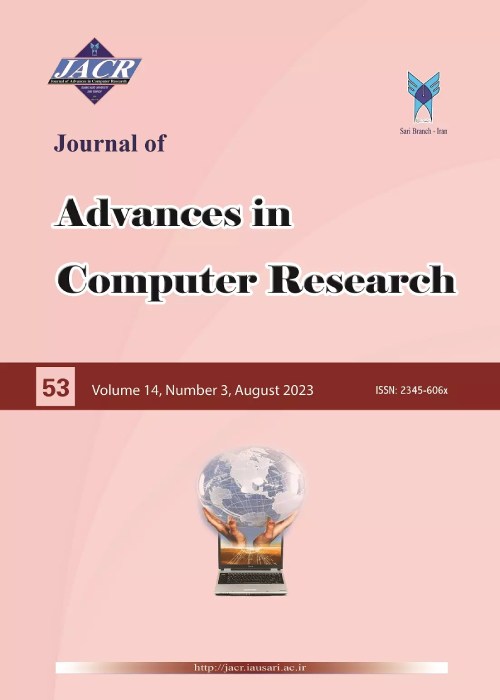فهرست مطالب

Journal of Advances in Computer Research
Volume:2 Issue: 4, Autumn 2011
- تاریخ انتشار: 1391/06/25
- تعداد عناوین: 8
-
Pages 1-12The Flexible Job Shop Scheduling Problem (FJSP) is one of the most general and difficult of all traditional scheduling problems. The Flexible Job Shop Problem (FJSP) is an extension of the classical job shop scheduling problem which allows an operation to be processed by any machine from a given set. The problem is to assign each operation to a machine and to order the operations on the machines, such that the maximal completion time (makespan) of all operations is minimized. The scheduling objective minimizes the maximal completion time of all the operations, which is denoted by Makespan. The goal of this research is to develop an efficient scheduling method based on Gravitational local search algorithm to address FJSP. we could reduce scheduling time and costs by transferring and delivering operations on existing machines, that is among NP-hard problems. Different methods and algorithms have been presented for solving this problem. Having a reasonable scheduled production system has significant influence on improving effectiveness and attaining to organization goals. In this paper, we design algorithm were proposed for flexible job shop scheduling problem (FJSP-GSA), that is based on Gravitational search algorithm (GSA). The experimental results showed that the proposed method has reasonable performance in comparison with other algorithms.Keywords: Gravitational search algorithm, Flexible job shop scheduling problem, Makespan, Mass, Gravitational force
-
Pages 13-28This study evaluates the discriminative power of sequential spectrum analysis of the short-term electrocardiogram (ECG) time series in separating normal and subjects with life threatening arrhythmias like, ventricular tachycardia/fibrillation (VT/VF). The raw ECG time series is transformed into a series of binary symbols and the binary occupancy or relative distribution of mono-sequences (i.e. tuples containing only one type of symbol ‘0’ or ‘1’) is computed. The quantified approximate entropies (ApEn0 and ApEn1) of the binary occupancies in the sequential spectra are found to have potential in discriminating normal and VT/VF subjects and thus can significantly add to the prognostic value of traditional cardiac analysis. The receiver operating characteristic curve (ROC) analysis confirms the robustness of this new approach and exhibits an average sensitivity of about 98.0% (97.1%), specificity of about 93.3% (93.3%), positive predictivity of around 94.7% (89.3%), and accuracy of about 95.9% (94.7%) with ApEn0 to distinguish between normal and VT (VF) subjects.Keywords: Ventricular tachycardia, Ventricular fibrillation, Sequential spectrum, Symbolic dynamics
-
Pages 29-40In recent years, soft computing methods have generated a large research interest. The synthesis of the fuzzy logic and the evolutionary algorithms is one of these methods. A particular evolutionary algorithm (EA) is differential evolution (DE). As for any EA, DE algorithm also requires parameters tuning to achieve desirable performance. In this paper tuning the perturbation factor vector of DE is done with a Fuzzy Logic Controller (FLC) that adjusts this parameter dynamically. We apply the fuzzy logic controlled differential evolution(FLC-DE) to solve the economic load dispatch problem of two test systems consisting of 13 and 40 thermal generators whose non-smooth fuel cost function takes into account the valve-point loading effects. Simulation results indicate that the performance of the FLC-DE present the best results when compared with other optimization approaches in solving economic load dispatch problems.Keywords: Differential Evolution, Economic Load Dispatch Problem, Fuzzy Logic Controller, Optimization
-
Pages 41-50Automatic road extraction from aerial images can be very helpful in traffic control and vehicle guidance systems. Most of the road detection approaches are based on image segmentation algorithms. Color-based segmentation is very sensitive to light changes and consequently the change of weather condition affects the recognition rate of road detection systems. In order to reduce the light change effects, a novel Otsu thresholding-based approach for automatic road detection is proposed. Otsu method calculates the optimum threshold value, which efficiently separates the two classes of road parts and non-road parts, so that their inter-class variance is maximal. Conducted experiments confirm the performance of the proposed method for detection of roads in different lighting conditions whilst the experimental images are taken from different geographical areas.Keywords: Automatic road detection, Edge detection, Morphological operators, Otsu thresholding method
-
Pages 51-59In this paper a novel all-optical logic NAND, NOR and XOR gate based on nonlinear directional coupler theory is demonstrated. We use the identical structure which contains three waveguides, for designing these gates; the only difference however, is the power of inputs light beam. In other words, while a beam with 4 W/µm in power considered as logical one, the output is NAND gate and if a beam with 6 W/µm in power considered as logical one, the same output, will be represented, the NOR function. In this case, an other waveguide of the structure is represented the XOR gate. Therefore this case, shows both NOR/XOR gates simultaneously. By use of three waveguides and adjusting the refractive index of waveguides and selecting the proper waveguide length, NAND/NOR/XOR gates can be obtained. The operation of these gates is simulated by use of Rsoft's BeamPROP simulator.Keywords: All, optical gates, Coupling, Nonlinear directional coupler, Refractive index, Waveguide
-
Pages 61-70We consider a grid network where nodes contain small buffers. A packet that faces a crowded buffer in its route will get extra latency and may be dropped. In this paper, we propose a novel flow control protocol called RFCC for grid networks. RFCC tries to reroute delayed packets and utilizes network coding to introduce a configurable amount of redundant information in the network, thereby increasing reliability in the face of packet loss. RFCC contains a number of mechanisms to adapt to the traffic model on a grid interconnection network in a multiprocessor system. Our simulation experiments show that RFCC improves reliability with comparable traffic overhead compared to the case in which RFCC is not used.Keywords: Grid network, Flow control, Network coding, Routing, Reliability
-
Pages 71-80Quantum-dot Cellular Automata (QCA) is an emerging and promising technology that provides significant improvements over CMOS. Recently QCA has been advocated as an applicant for implementing reversible circuits. However QCA, like other Nanotechnologies, suffers from a high fault rate. The main purpose of this paper is to develop a fault tolerant model of QCA circuits by redundancy in hardware and also identifying the faulty module by a proposed Reversible QCA comparator circuit. Triple Module Redundancy (TMR) mechanism is implemented for Reversible QCA circuits to make them more Reliable. Our proposed Comparator and Detector design uses the minimum number of clocking zones and maximizes the circuit density and focuses on a layout of the circuit which is minimal in using QCA cells. QCA Designer ver.2.0.3 is used for simulation and verifying the design.Keywords: QCA, Reversible computing, Fault, Redundancy, TMR
-
Pages 81-93This paper proposes a novel hybrid algorithm namely APSO-BFO which combines merits of Bacterial Foraging Optimization (BFO) algorithm and Adaptive Particle Swarm Optimization (APSO) algorithm to determine the optimal PID parameters for control of nonlinear systems. To balance between exploration and exploitation, the proposed hybrid algorithm accomplishes global search over the whole search space through the APSO algorithm whereas the local search is performed by BFO algorithm. The proposed algorithm starts with APSO algorithm. In the proposed APSO, every particle dynamically adjusts inertia weight according to feedback taken from particles best memories. In this case, APSO algorithm is used to enhance global search ability and to increase convergence speed. When the change in fitness value is smaller than a predefined value, the searching process is switched to BFO to accelerate the search process and find an accurate solution. In this way, this hybrid algorithm may find an optimum solution more accurately. To demonstrate the effectiveness of the proposed algorithm, its results are compared with those obtained by Basic PSO (BPSO), Standard BFO (SBFO), BFO with PSO (PSO-BFO), BFO with GA (GA-BFO) and Differential Evolution with BFO (DE-BFO). The numerical simulations are shown the potential of proposed algorithm.Keywords: Bacterial foraging optimization algorithm, Particle swarm optimization, PID controller, Genetic algorithm, Differential evolution


